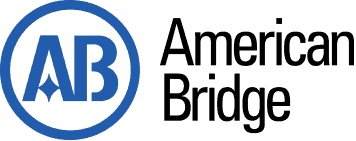History
The history of American Bridge Company is rich with record breaking spans, never before seen engineering and construction techniques, and countless innovations that have set us apart.
Founded as a JP Morgan-engineered merger of 28 bridge and structural companies in 1900, we have set ourselves apart pursuing and completing legendary bridge, marine, and complex structure projects worldwide. This is our history, and our future.
In the 1800s, the makings of American Bridge Company were already in motion. In 1874, the Keystone Bridge Company completed the Eads Bridge – the first steel bridge across the Mississippi River. In 1900, Keystone Bridge Company became part of American Bridge. The Eads Bridge has three arch spans that are 502, 520, and 502 feet in length. Each span has four truss-stiffened arches with parallel chords, 12 feet apart, made of wrought iron tubes 16 inches in diameter, with chrome steel staves inside. The top deck of the bridge comprises four lanes of traffic and one pedestrian lane. The bottom deck is made up of two track MetroLink light rail service. Today, the Eads Bridge still serves as a fully functional superstructure that connects St. Louis, Missouri to East St. Louis, Illinois.

American Bridge Company was formed as a JP Morgan-engineered merger of 28 steel companies in 1900. On April 1, 1901, American Bridge became a subsidiary of the United States Steel Company (another JP Morgan engineered roll-up), where it was incorporated in the state of Delaware.
Immediately after the merger, American Bridge started a program of building and modernization that closed some of the plants and modernized others. The Company soon embarked on the building of a new fabricating and manufacturing facility in southwestern Pennsylvania that was completed in 1903 and became the largest such facility in the world. A town grew around the plant and became known as Ambridge, a conjunction of “American” and “Bridge”.
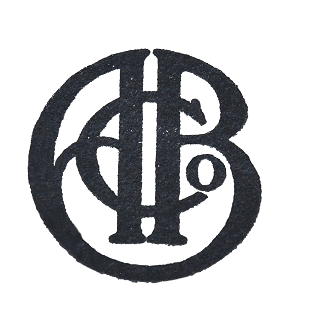
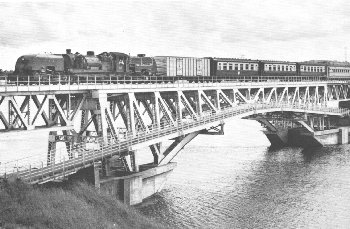
Notable projects in this decade included the supply and erection for the 27 bridges through the Rift Valley on the Uganda Railroad in Kenya, the 145th Street Swing Bridge in New York City, the Conn River RR bridge in Old Saybrook (currently owned and operated by Amtrak); and the Hakonarstadir Bridge over the Jökulsá River in Iceland.
With these substantial resources, American Bridge set out as an industry leader in the fabrication and erection of complex structures of all types. Our unique and ever-developing capabilities have resulted in our involvement with notable, major bridge and other structural projects through to the current day. Though our development has taken us far beyond a steel specialty, this original core, engineering driven, no project is too difficult attitude remains a key part of our culture today.
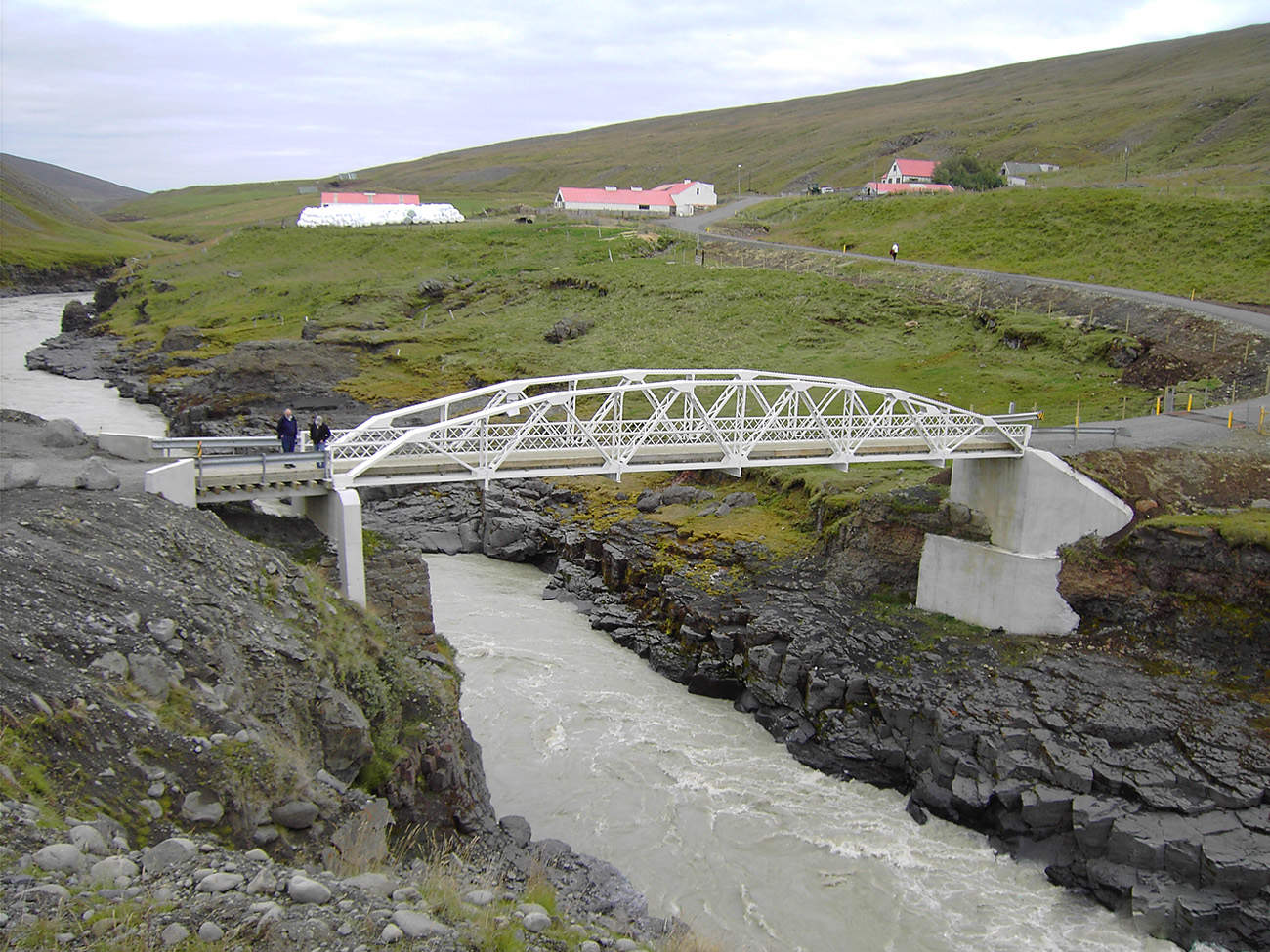
In 1915, the Ambridge Plant fabricated the Fair-Body portion of the hulls of eight sea-going tankers for the Chester Shipbuilding Company of Chester, Pennsylvania. This was the first time that a bridge and structural steel fabricating shop had used bridge-shop methods in the fabrication of hull steel for seagoing vessels as against the usual “cut and fit” methods prior to that time.
American Bridge completed the Hell Gate Arch Bridge in 1916. At the time of construction, it was the longest arch bridge in the world, and is still one of the heaviest.
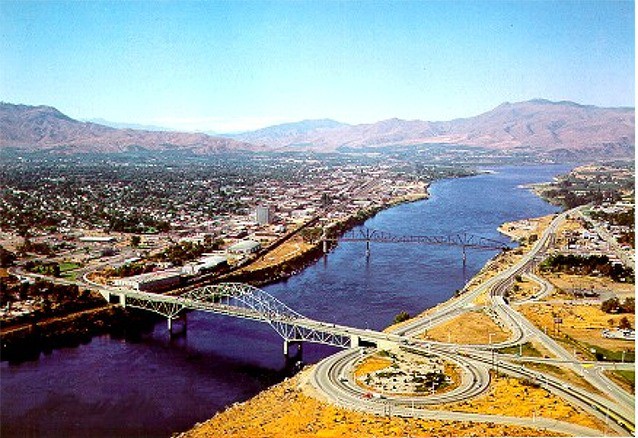
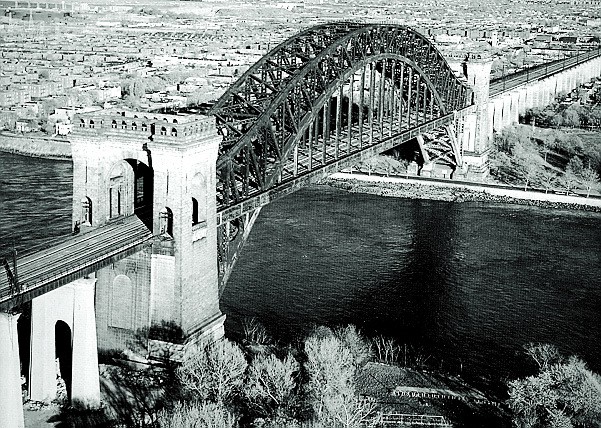
Other notable projects in this decade include the Kentucky River High Bridge in Jessamine County, Kentucky; 81 railroad bridges for the Philippines Railroad System; the Atbara River Bridge in Sudan; the Manchester Bridge in Pittsburgh; six movable bridges for the Panama Canal Authority (used as emergency dams); the Columbia River Bridge at Vancouver, WA (now carrying I-5); the Union Pacific Railroad bridge over the Missouri River at Omaha, and the Metropolis railroad bridge over the Ohio River in Illinois, now owned by Canadian National Railway.
Between 1926 and 1928, American Bridge erected and fabricated the well-known Roberto Clemente Bridge (6th Street), Andy Warhol Bridge (7th Street), and Rachel Carson Bridge (9th Street) in Downtown Pittsburgh. Also known as “The Three Sisters,” American Bridge used an innovative approach to turn the eyebar catenary/deck girder system temporarily into a truss by adding a diagonal to enable erection by balance cantilever and avoiding falsework in the river. These nearly identical, self-anchored, eye-bar suspension bridges are familiar landmarks when overlooking the Pittsburgh skyline.
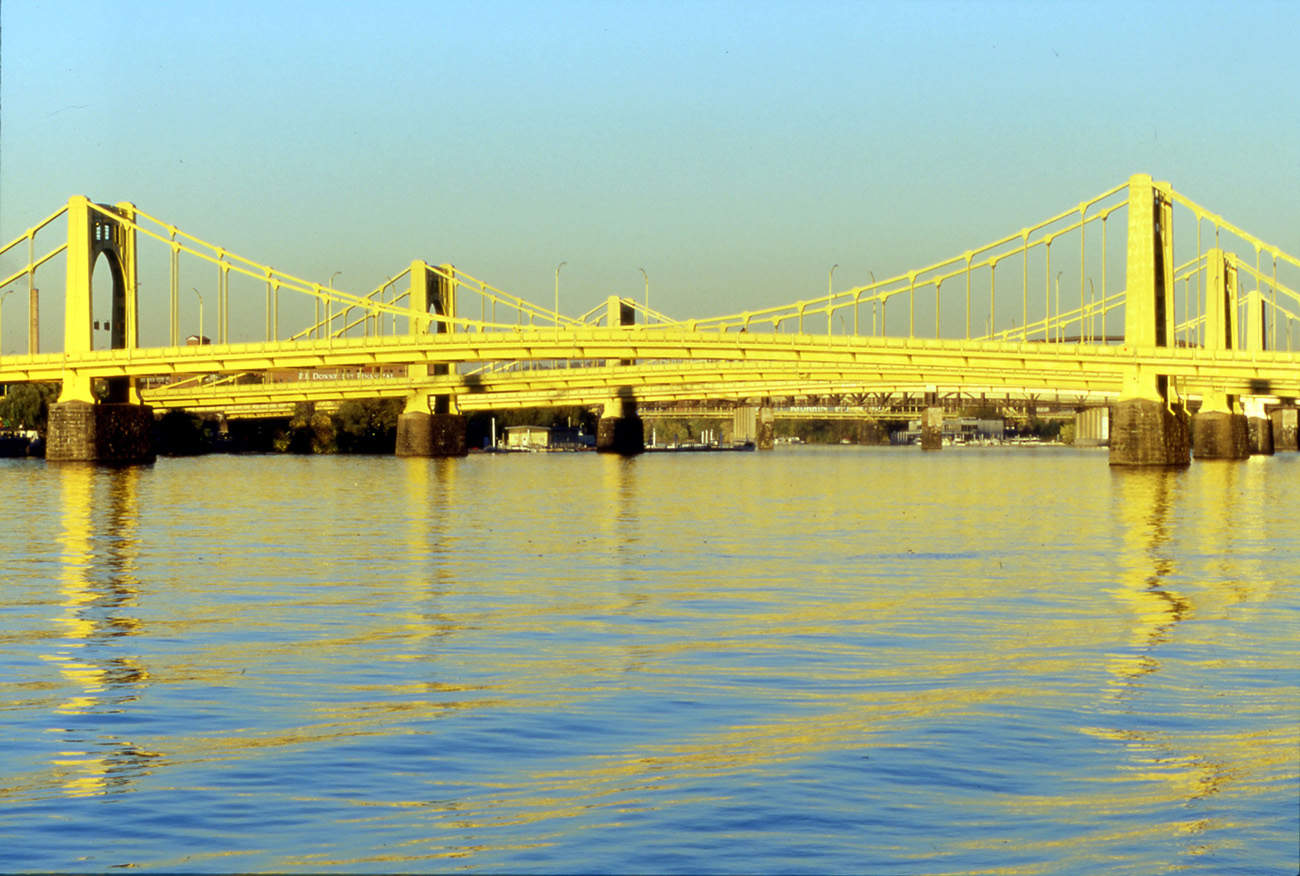
In 1929, American Bridge began airspinning cable with the construction of the Mid-Hudson Bridge in Poughkeepsie, NY. American Bridge fabricated and erected the towers, stiffening truss, cables, and roadway deck for this suspension bridge, requiring 13,275 tons of structural steel and 2,200 tons of cable. This began a long history of suspension bridge cable erection for American Bridge that continues to this day. To date, American Bridge has airspun well over half a million miles of suspension cable.
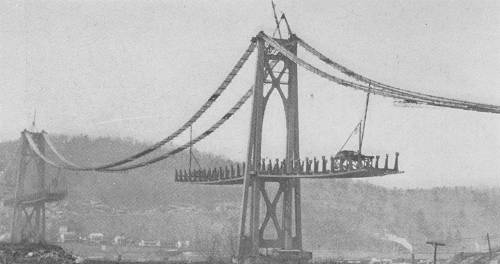
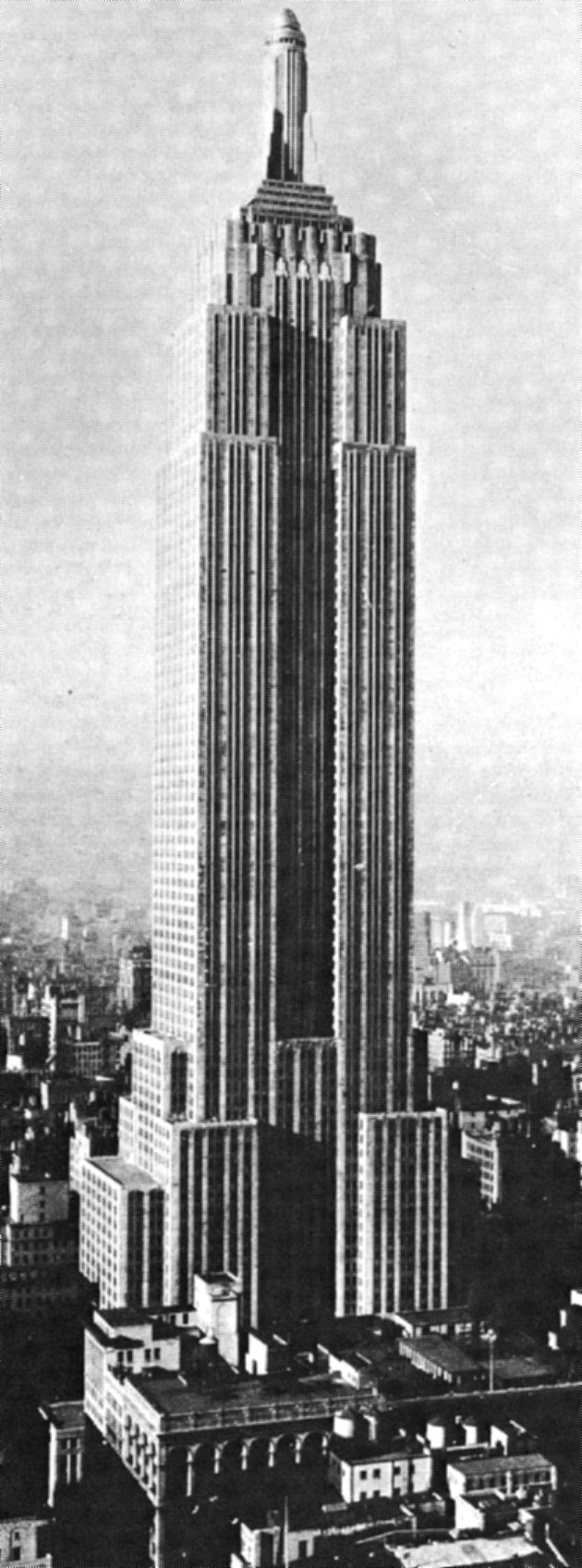
American Bridge was involved in the fabrication and erection of the Empire State Building, an 86 story office building; the tallest in the world when it was completed in 1930.
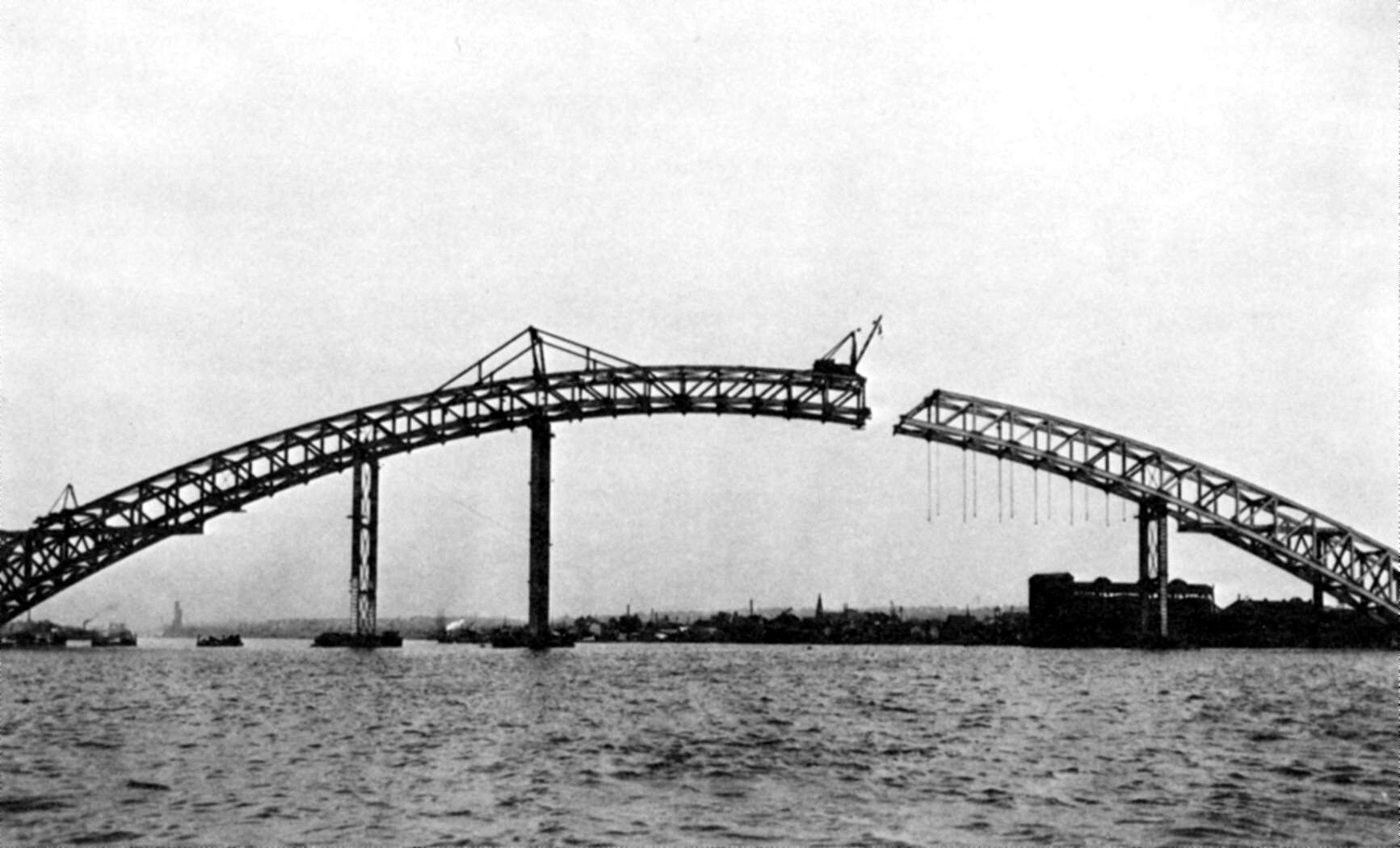
American Bridge completed the Bayonne Bridge in 1931, the longest arch superstructure in the world at the time. Soon after, American Bridge was chosen as the General Contractor for the East and West Bay portions of the Original San Francisco-Oakland Bridge.
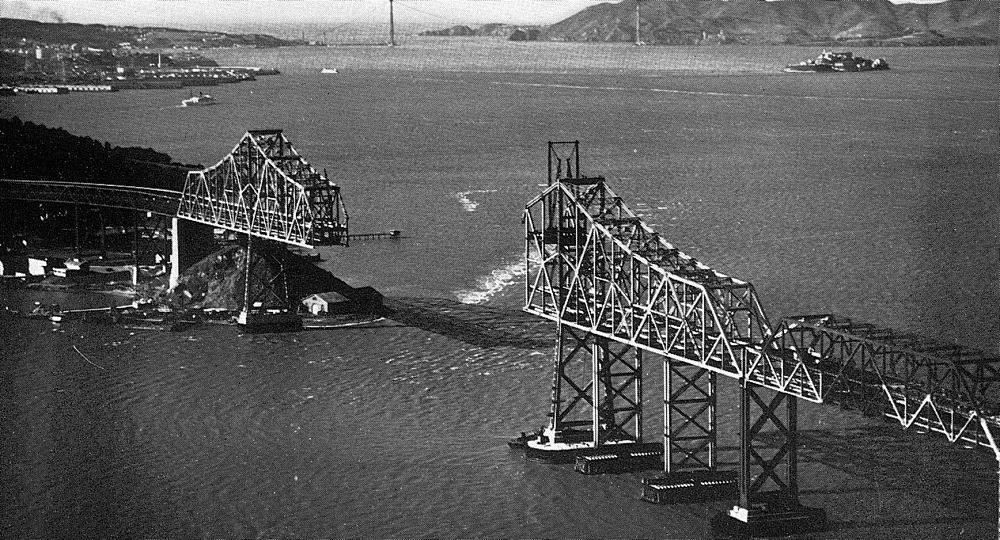
The San Francisco-Oakland Bay Bridge Project was completed in November 1936. That same year, the Virginia Bridge & Iron Company of Roanoke, Virginia, operating plants in Roanoke, Memphis, and Birmingham were acquired by American Bridge.
By 1938, American Bridge had furnished and erected bridges in 69 foreign countries and overseas US territories.
100% of American Bridge’s capacity was utilized for National Defense projects from 1941-1945. American Bridge manufactured 199 LST’s as well as four Aviation Repair Vessels, major components for 11 Essex Class Aircraft Carriers, one Super-aircraft Carrier, and 31 Auxiliary Converted Aircraft Carriers, 77 C Type Cargo Ships, four Tankers, 20 Cargo Lighters, and 348 Knock-down Barges.
Other war related projects included the construction of a grassroots steelmaking facility in Geneva, Utah; major Aluminum manufacturing facilities in Tennessee, and steel mill expansions in Pittsburgh. American Bridge also built militarily strategic bridges including the Harry Truman vertical lift rail bridge in Kansas City; the Terminal Island rail bridge in Long Beach; and the Liard River Suspension Bridge on the Alaska Highway in British Columbia – all still in use today.
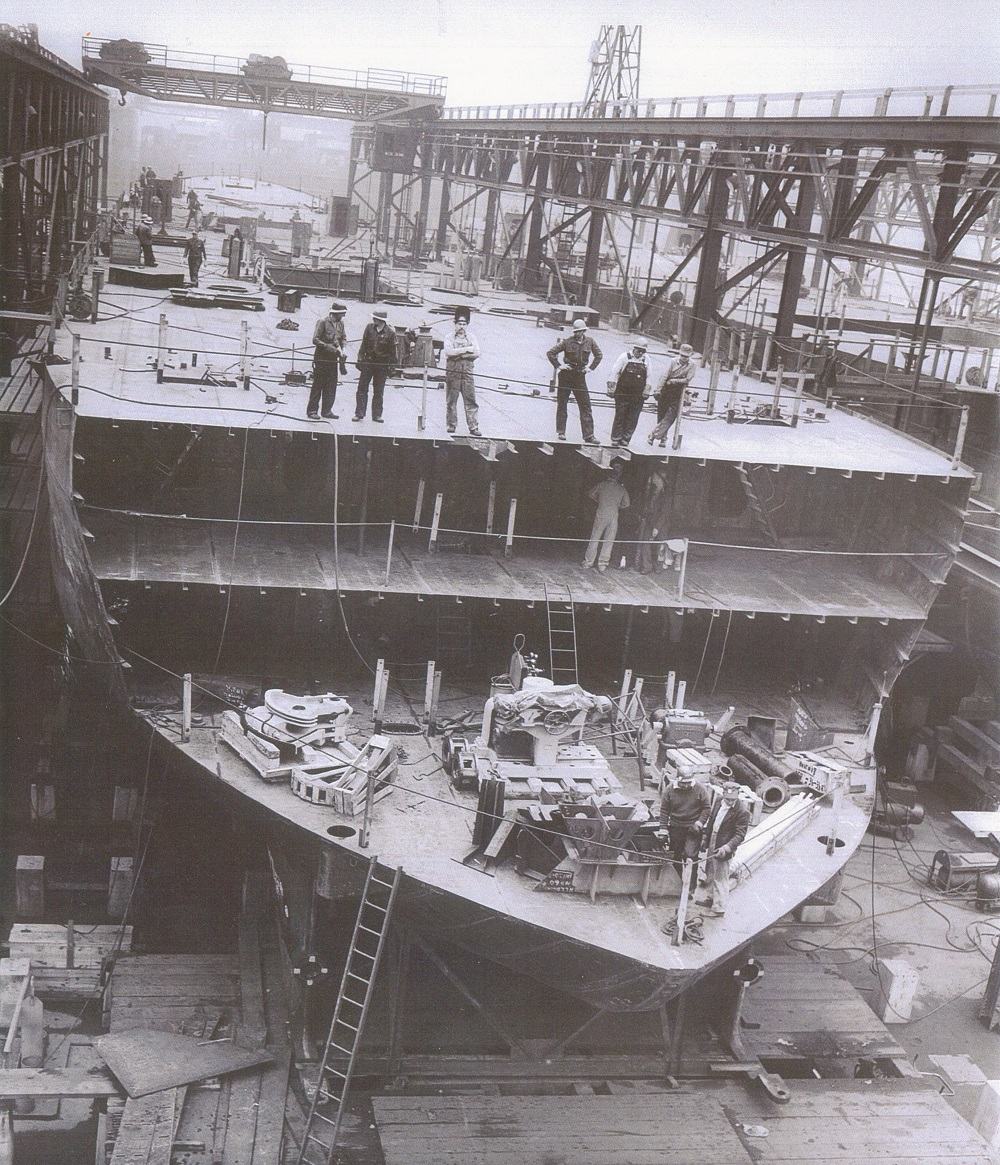
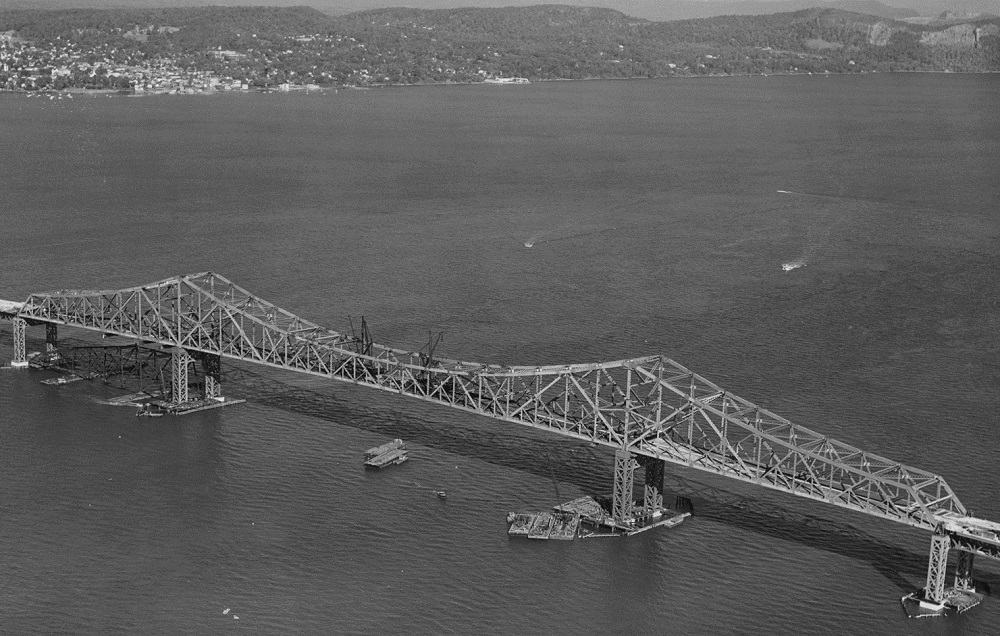
American Bridge was prime superstructure contractor for the original Tappan Zee Bridge crossing the Hudson River above New York City. Although plans for this new bridge began in the 1920’s, construction didn’t start until March of 1952. Construction was completed in 1955.
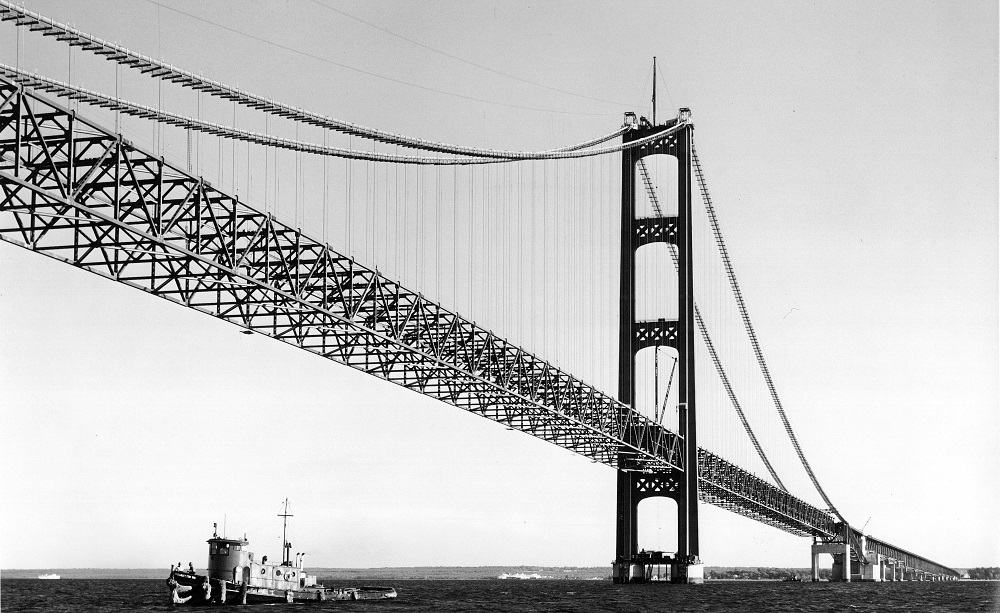
In 1957, American Bridge fabricated and erected the entire 47 span superstructure for the Straits of Mackinac Bridge. The 18,343-foot-long bridge remains one of the longest total suspended spans in the world. It was elected to be a National Historic Civil Engineering Landmark on August 12, 2010 by the American Society of Civil Engineers.
In this decade American Bridge constructed Launch complexes 40-41 at Kennedy Space Center; the Norad Combat Operations Center in Colorado Springs; over 600 Minuteman Missile sites throughout Wyoming, Missouri, North Dakota, and Montana, and the Space Propulsion Facility at NASA Lewis Research Center in Sandusky, Ohio. The company continues to be active in this field today, with more recent projects including the Aeropropulsion Systems Test Facility at Tullahoma, Tennessee, numerous launch and processing facilities at Vandenberg Air Force Base, California, and Complex 17B at Cape Canaveral Air Force Station, Florida.
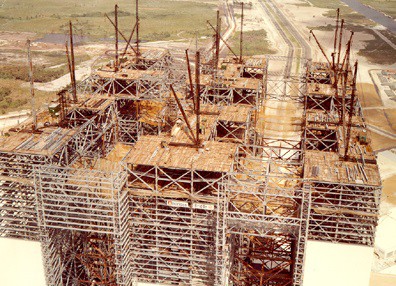
American Bridge has had a long history with the US Space Program; constructing wind tunnels, lab buildings, launch complexes, and rocket assembly buildings. In 1964, American Bridge completed the superstructure for the Vehicle Assembly Building at Kennedy Space Center. At 3.7 million cubic meters, this building remains one of the largest in the world.
American Bridge held the prime construction contract for the cables and suspended spans of the Verrazzano-Narrows Bridge in New York City. AB’s scope of work consisted of the largest air spinning project completed at the time. Four 36 inch diameter main cables encompassed 143,000 miles with the cables weighing over 38,000 tons, the feat becoming a world record. AB also fabricated and erected the 101-foot-wide, 24-foot-deep, double-deck, 6,690 foot suspended truss, which weighed 44,000 tons. In addition AB hung 389,000 linear feet of suspender ropes, and fabricated and placed nearly 100,000 square feet of steel grid deck. Upon completion it became the longest suspension bridge in the world until 1981. Today, it remains the longest suspension bridge in North America.
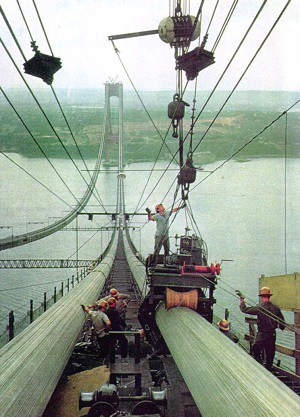
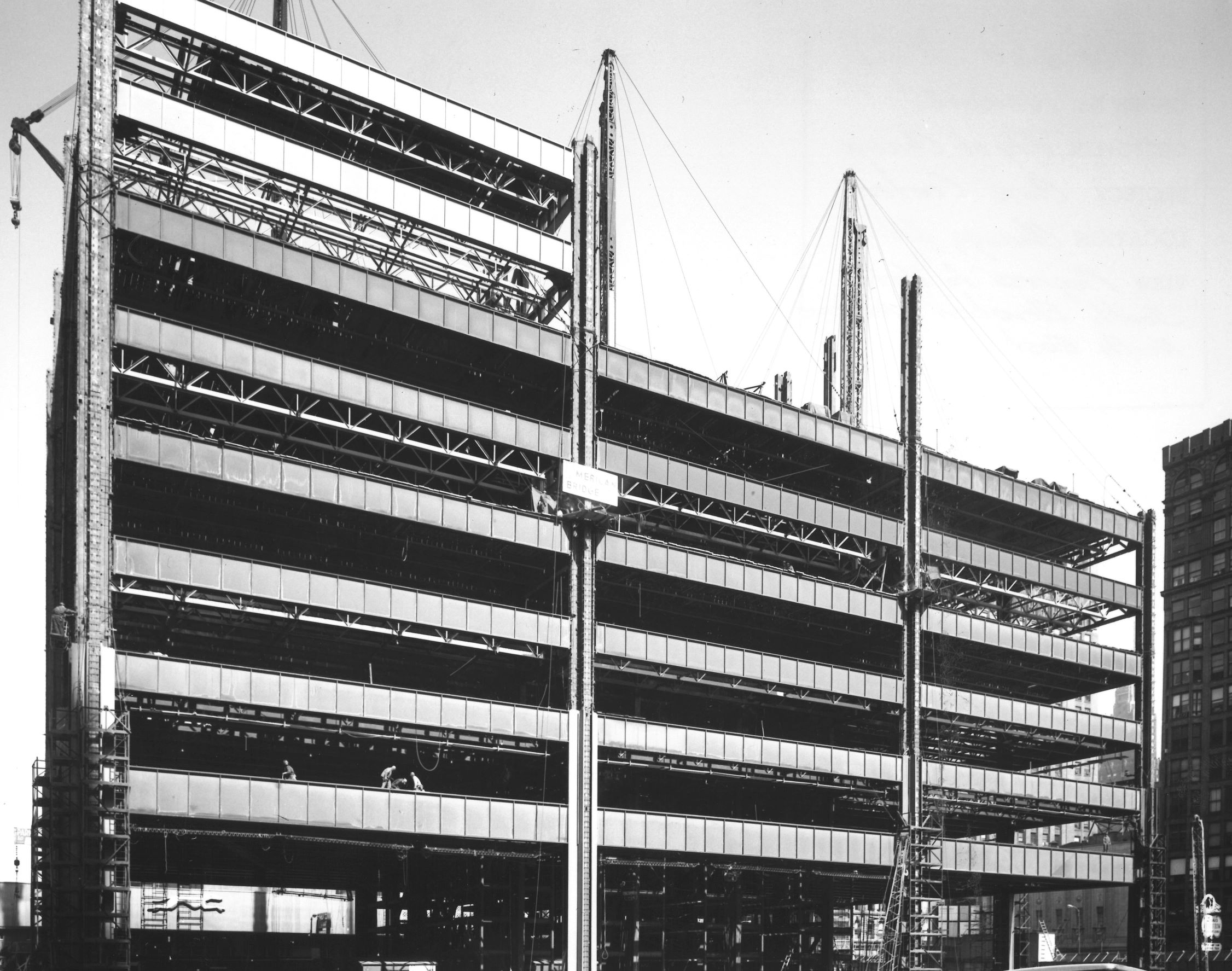
In 1964, American Bridge fabricated and erected the Chicago Civic Center Building in Chicago, Illinois. The 31 story office building features COR-TEN steel which is weathering steel designed to form a rust-like appearance and eliminate the need for painting.
Three years later, AB fabricated and erected Chicago’s Picasso, a 50-foot-high sculpture to the design of Pablo Picasso. Located in the Plaza at the Chicago Civic Center, this special structure has a total weight of 162 tons.
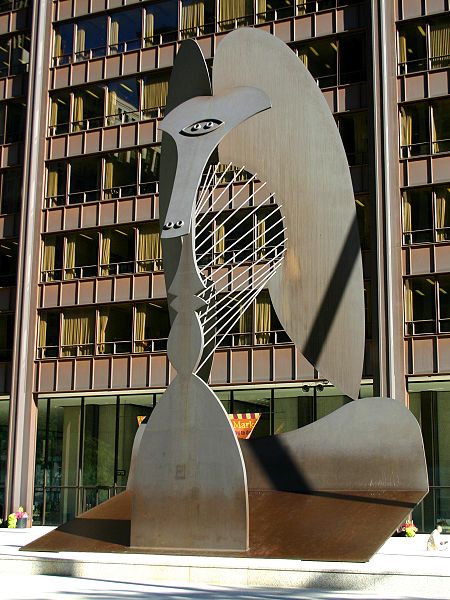
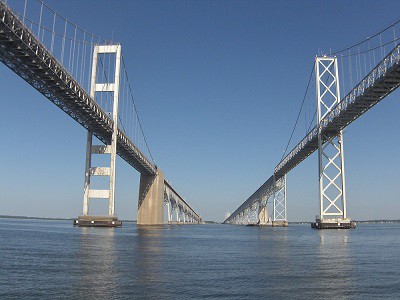
American Bridge began construction as general contractor for the superstructure for the 32-span, 14,500 foot (4,420m) William Preston Lane, Jr. Chesapeake Bay Bridge in Annapolis, Maryland in 1970 and completed the project just three short years later. The crossing included a 1,600’ mainspan suspension bridge, and marked American Bridge’s first use of prefabricated parallel wire strands for the main suspension cables. These were self-fabricated by American Bridge in facilities in the Fairless Works of US Steel in Philadelphia.
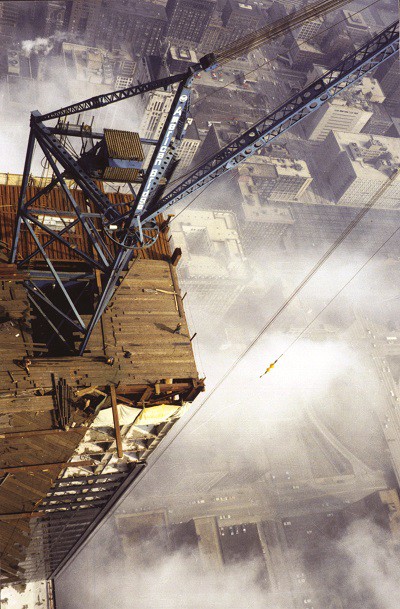
In 1973, American Bridge fabricated and erected 78,000 tons of structural steel for the Sears Tower in Chicago, Illinois. Today, it is known as the Willis Tower and remains one of the tallest buildings in America.
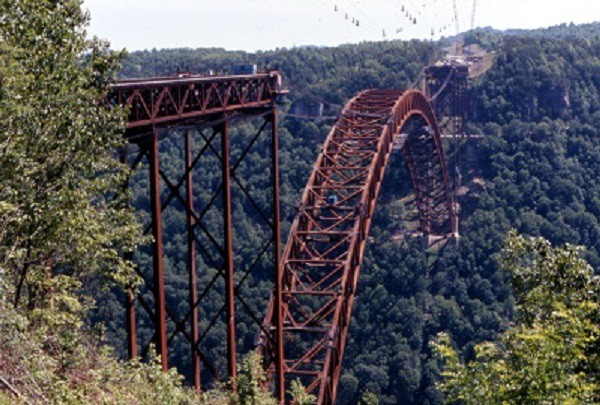
This same year, 550 miles south, American Bridge began construction on the longest deck arch bridge in the world. At 1,700 feet, pin to pin and 3,030 feet overall, the New River Gorge Bridge was then the longest arch bridge in the world. With a deck some 900’ above the New River, it is also one of the highest in the world. Its construction fully challenged American Bridge’s prodigious in-house engineering capability, including design of a 100-ton capacity cableway to erect the arch segments and a tieback system for the uncompleted arch arms with a capacity of 50,250 kips.
In a joint venture with Morrison Knudsen Corp, American Bridge was general contractor for the 5.3 mile monorail connection between the Magic Kingdom and EPCOT theme parks. AB fabricated 41,000 linear feet of precast concrete haunched girder beamway and 278 precast piers, drove 766 steel shell step taper piles aggregating 53,288 linear feet, formed and placed concrete pilecaps and spread footers aggregating 14,933 cubic yards, erected piers and beamway, grouted joints and electrified the beamway. The monorail includes 12,909 feet of double beamway supported on single piers and 15,136 feet of single beamway.
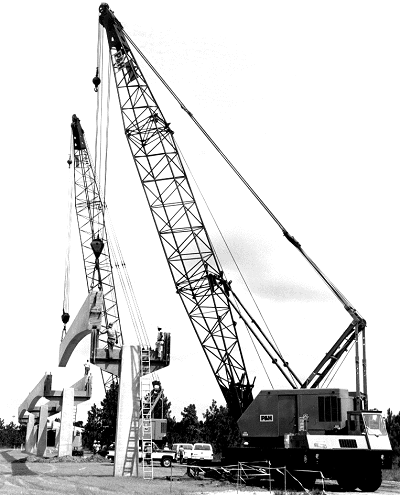
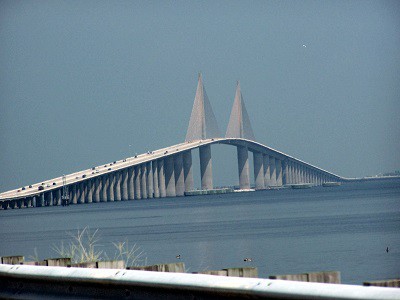
Also in joint venture with Morrison Knudsen and Pascen Construction, American Bridge was general contractor for the all-concrete, 8,858-foot Sunshine Skyway high level bridge in Tampa, Florida. The bridge is one of the earliest concrete segmental structures in the USA, and was erected through a variety of methods including balanced cantilever and overhead gantry erection cranes. The work was conducted over a busy ocean navigation channel, and in open ocean conditions. The stay cables were site fabricated and erected by the JV. Completed in 1986, this was the third bridge American Bridge had constructed at the site. The first two were cantilevered steel trusses.
In 1996, American Bridge was awarded the Tagus River Suspension Bridge rail deck addition in Lisbon, Portugal. This unprecedented project required the airspinning of two new main cables on an active suspension bridge carrying over 250,000 vehicles per day, and the transfer of partial load of the bridge to the new cables. Completed in 1998, the project received the George S. Richardson Medal in 2001, an Advancement of Bridge Technology award. Using controlled tension methods, this project broke all existing airspinning records by achieving over 73% efficiency (actual trips/max theoretical trips).
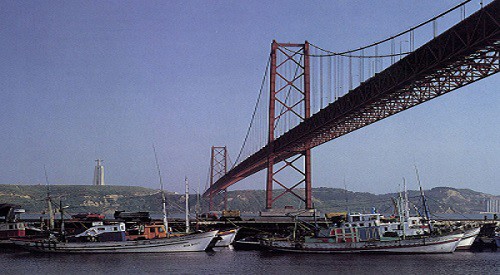
American Bridge started work on a private island in June of 1996. The island, formerly known as Gorda Cay, was uninhabited, had no improvements, and no berthing facilities even for construction craft. It is located about nine miles west of the southwest tip of Great Abaco Island. While schedule and the diversity of crafts would have made this a challenging project in the USA, the logistics of delivery of materials and equipment, establishment of a workforce, housing and transport of professional personnel, work permits, staging, customs clearances, cultural adjustment, unavailability of spare parts or repairmen, sometimes violent weather, unavailability of subcontractors, etc. made this a truly formidable undertaking for American Bridge.

In 2002, American Bridge completed the Lions Gate Bridge Rehabilitation that began in 1998. In yet another unprecedented challenge, the work included the replacement of the entire superstructure of the suspension bridge during nighttime closures, keeping the bridge open to traffic during the day. To accomplish this, American Bridge engineers designed a unique link structure that maintained the continuity of the stiffening truss, an overhead gantry to lower and lift the segments, methods for maintaining equal loading of the hanger system, methods for replacing the hangers, and many other innovations.
The work also included the reconstruction of the Stanley Park Causeway as well as the design-build seismic upgrade of the north approach viaduct of the bridge. Extensive coordination was required with the Port of Vancouver as the bridge is over the entrance to a major ocean navigation channel.
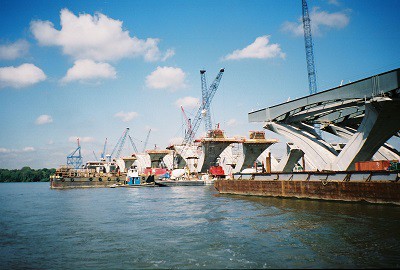
Also in this decade, American Bridge constructed the world’s largest movable bridge. The eight-leaf Woodrow Wilson Bascule was begun in 2003 and completed in 2008, and contained cast-in-place segmental piers, precast segmental piers, and structural steel superstructure. American Bridge self-performed all mechanical installations on the movable spans.
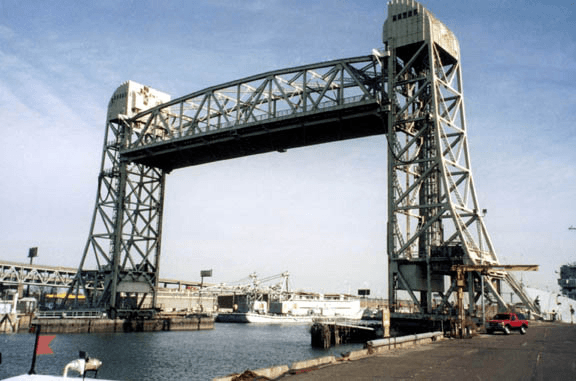
Other major projects in the 2000’s included the Philadelphia Naval Lift Bridge, the combined road/rail Florida Avenue Lift Bridge in New Orleans, The Cumberland Lake truss bridge in Kentucky, and major rehabilitations to the RFK Triborough and Macombs Dam bridges in New York City.
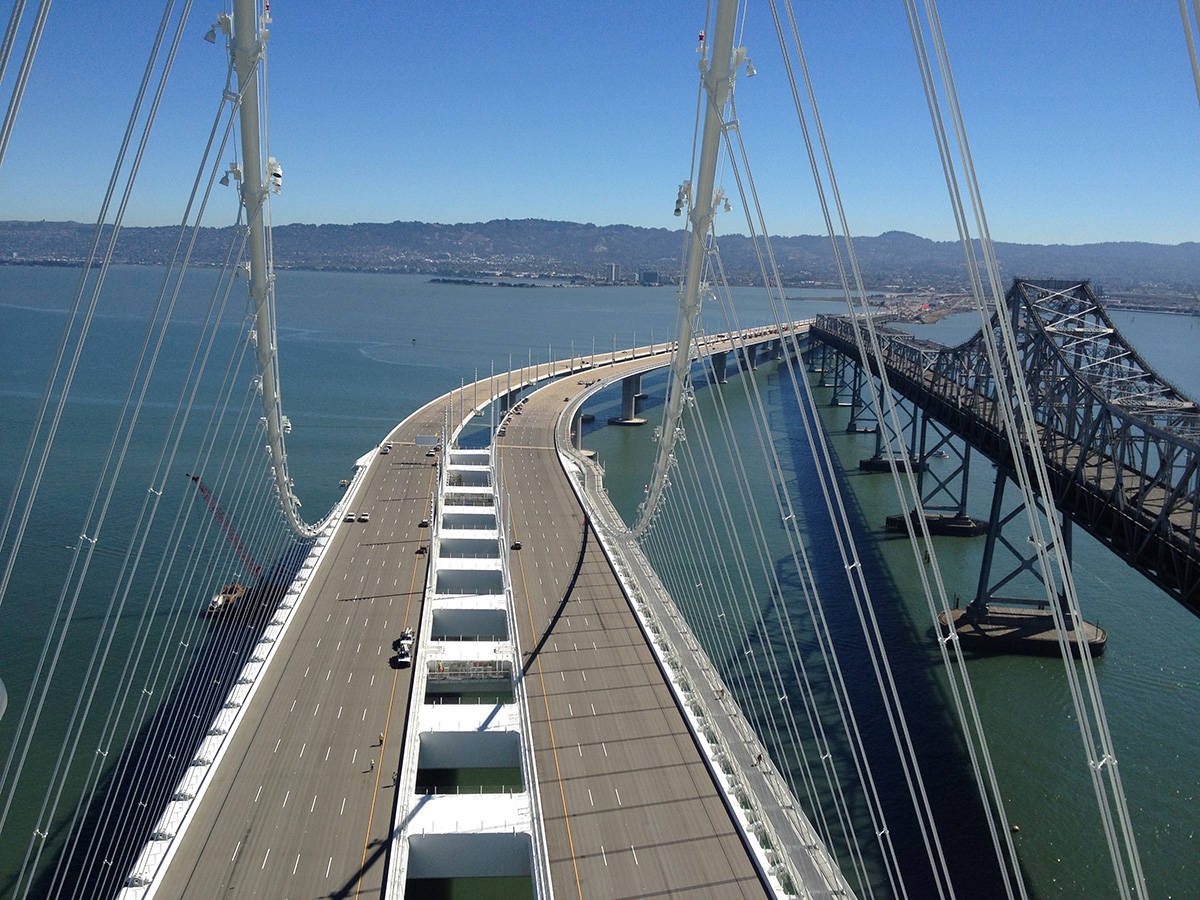
American Bridge is part of an integrated joint venture that holds the design-build contract for the Queensferry Crossing in Edinburgh, Scotland. This project consists of the improvement of 9km of urban divided motorway, including a 2,600m crossing of the Firth of Forth. The three tower cable stay bridge contains two 650m spans over ocean navigation channels. The composite steel tub/concrete deck superstructure is supported by a unique system of crossing stays. The team designed and constructed six special erection gantries that took advantage of the stay webs in the center of the bridge. The foundation system included three circular, 30m diameter sunken caissons, excavated to bedrock at a depth of 40m. The north and south approach viaducts were each launched, one incrementally and one in a single movement.
In 2014 the American Bridge/Fluor Joint Venture completed the San Francisco/Oakland Bay Bridge Self-Anchored Suspension Superstructure. This massive undertaking required the design of a temporary bridge upon which to erect the permanent bridge, until the cables could be erected and anchored in the new deck and the load could be transferred to the new cables. The JV designed and constructed a 1,750 metric ton capacity shearleg crane to erect the 1,500 tonne segments, along with methods to skid and position them. Bespoke methods were also developed to pull the prefabricated parallel wire strands around the deck anchorage, to tip up the steel tower sections, and to transfer the 35,000 tonne superstructure load from the temporary bridge to the cables, an operation complicated by the unique inclination of the main cables.
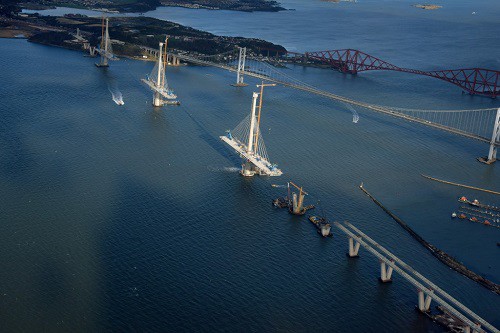

Also in 2014, American Bridge completed the world’s largest observation wheel in Las Vegas, Nevada. The project required the development of a wide variety of methods and equipment, including a strut system to support the progressively erected rim, a tieback tower to support the eccentrically loaded partially built structure, a hydraulic rotating mechanism to advance the incomplete rim, a temporary structure to allow the mating of the bearings to the spindle, a cable spoke tensioning system, a cabin erection procedure, and many other items. Like many American Bridge projects, this represented the unique strength of our ability to marry powerful engineering know-how with the legendary can-do capabilities of America’s union ironworkers and the supervision developed over many years of unique projects.
American Bridge is also part of the JV constructing the new Tappan Zee Bridge over the Hudson River in New York. This project includes twin 15,800’ structures with cable stay channel spans. The foundations include over 1,000 steel pipe piles up to 350’ in depth, precast tub pilecap structures in the approaches, and mainspan pilecaps constructed of precast segments stitched together and lowered in a synchronous jacking process. The steel superstructure for the long approaches was designed to enable assembly line fabrication of repetitive and easily transportable 60-120′ girders. The JV receives these components in a specially prepared yard about 100 miles upriver, where it assembles them into two or three-girder segments of up to 410’ in length complete with mechanical and electrical installations. The segments, weighing in excess of 1,100 tons, are then floated downriver and erected with the same shearleg crane used in the construction of the San Francisco Oakland Bay Bridge Self-Anchored Suspension Span project.
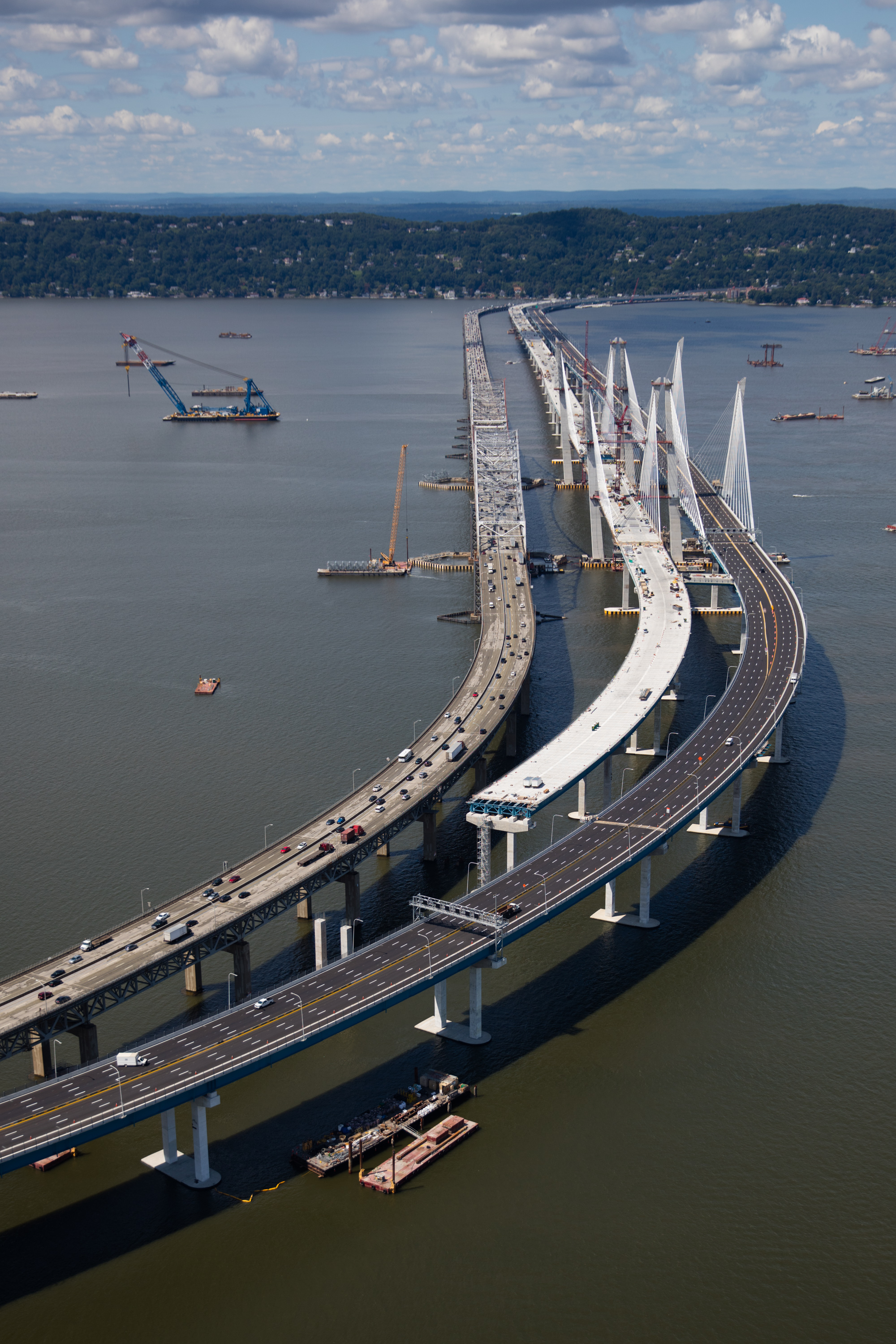
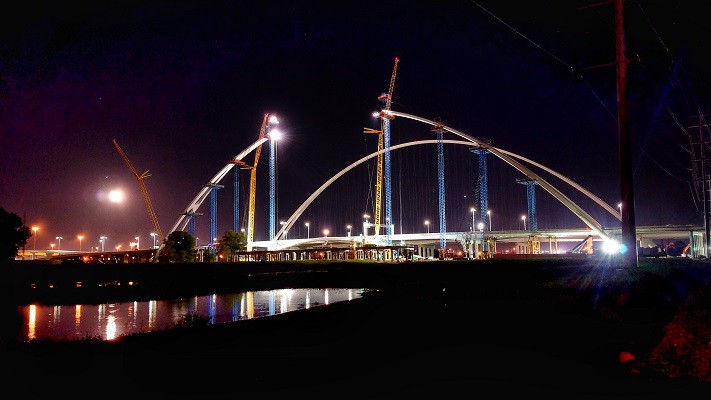
Another unique project by American Bridge is the pedestrian arch bridges that are part of the Horseshoe Project in Dallas. These twin, 1,100’ true arch bridges reach a height of 287’, and were erected on the same falsework sections used for the struts in the Las Vegas High Roller.
In 2014, American Bridge began the Angus L. Macdonald Bridge Suspended Spans Deck Replacement project in Halifax, Nova Scotia, known locally as “The Big Lift.” The project involves a complete replacement of the bridge’s suspended spans, while keeping it operational – making this only the second time this type of project has ever been completed (the first was also completed by AB on the Lions Gate Bridge in 2002). The work for this 762-meter suspension bridge involves the replacement of the superstructure in 46 segments; eight on the Dartmouth Side Span, 22 in the Main Span, and 16 on the Halifax Side Span.
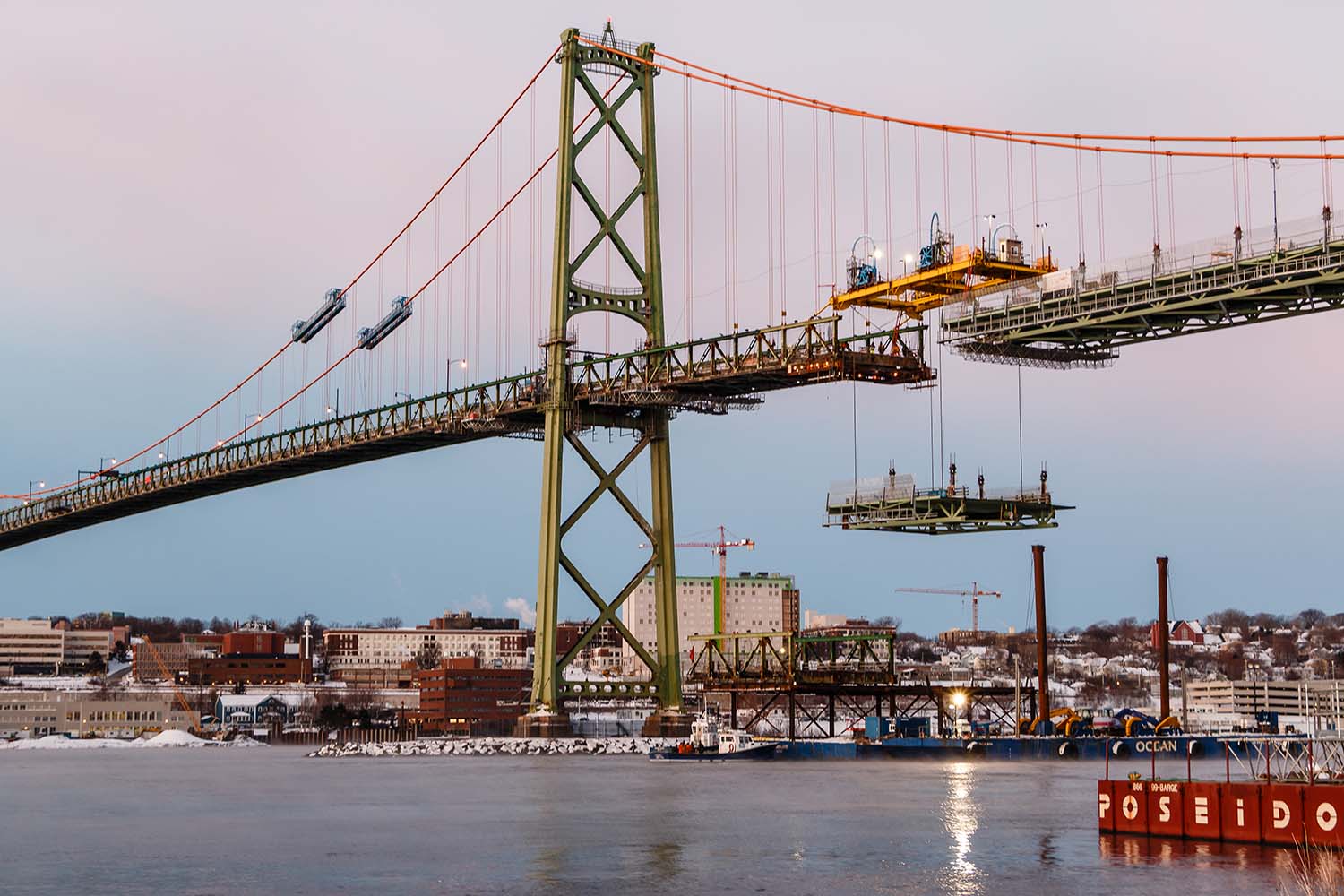
In addition to the superstructure replacement, the work also involves replacing cable band bolts, traction rods, certain cable bands, all joints and bearings including pendulum and rocker link truss end supports, and all 148 suspender ropes. Modifications to the main towers and the cable bents, as well as the addition of new main cable handstrands and a cable dehumidification system, are also included in the project scope.
American Bridge was the general contractor for the Portageville Bridge Replacement in Letchworth State Park in Portageville, New York. The Portageville Bridge, now known as the Genesee Arch Bridge, is a vital link along Norfolk Southern’s Southern Tier Route, crossing the Genesee River Gorge. The existing structure, built in 1875, was no longer able to efficiently handle modern transportation needs. A new bridge was necessary, and in November 2015, construction began on the new arch bridge.
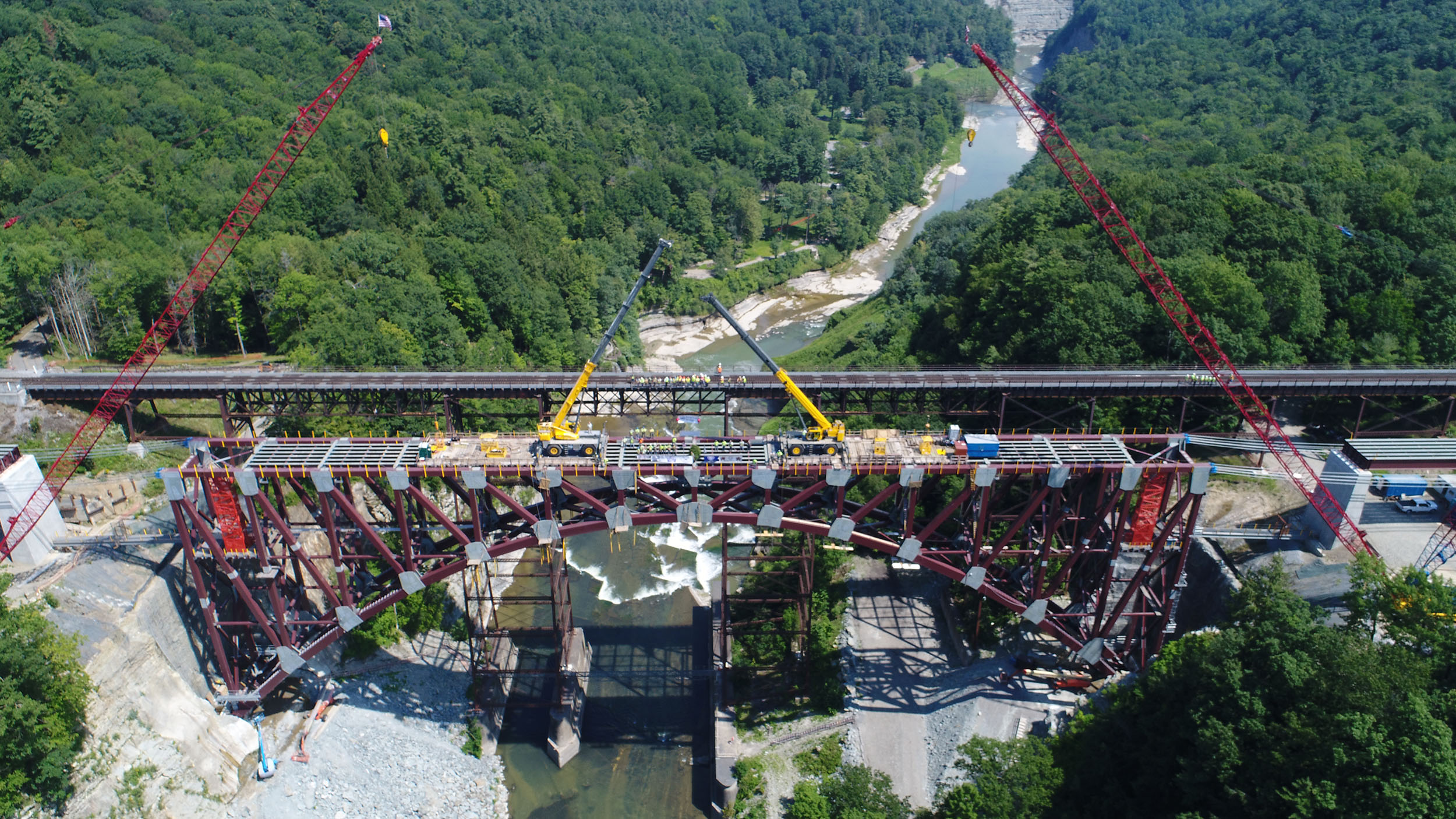
The new structure, built on an adjacent alignment just 75 feet south of the old bridge, is a single-track crossing with a ballast-filled concrete deck. The main span is a 483-foot-long arch with three 80-foot-long girder span approaches on each end, for a total length of 963 feet. The deck sits 235 feet above the Genesee River. The new bridge was opened to rail traffic on December 11, 2017, and the old structure was removed by American Bridge following the opening. The crossing now has no weight or speed restrictions, aligning it with industry standards.
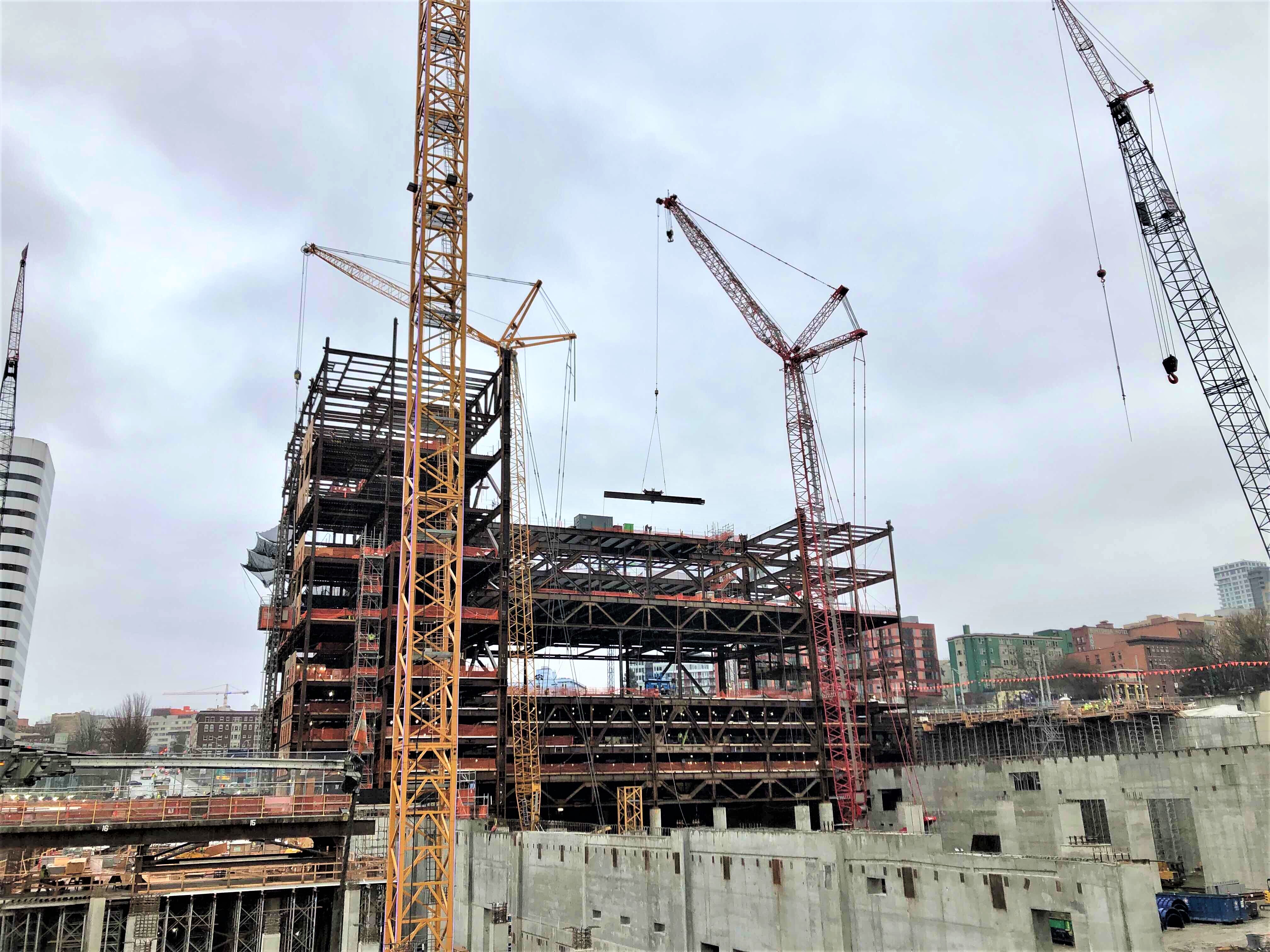
The Washington State Convention Center, in downtown Seattle, WA, is gaining a 1.5 million square-foot addition which is located one block northeast of the existing facility and will double the convention center’s capacity. The project includes construction of a new ballroom, flex space with an outdoor terrace, and a new exhibit hall. The addition, named the Summit, is a 14-story structure that will provide views of the Puget Sound and surrounding city. AB’s scope of work includes supplying and erecting approximately 21,000 tons of structural steel, 1,400,000 square-feet of metal decking, 36 sets of pre-engineered metal stairs, 157 buckling restrained braces and over 50,000 pieces of miscellaneous metals items. Currently, erection of the structural steel is underway. AB is erecting the steel from east-to-west, instead of the traditional bottom-to-top approach, this method results in a shorter construction duration, simplifies logistics, and improves workflow.
The Ed Koch Queensboro Bridge, also known as the 59th Street Bridge, is a major crossing of the East River between the boroughs of Manhattan and Queens in New York City. The 3,724-foot-long double-decked cantilever bridge has four lanes on the upper deck and five lanes on the lower level. American Bridge is the general contractor performing rehabilitation consisting of demolition of the existing concrete filled grid deck, installation of steel orthotropic deck, installation of additional steel framing, miscellaneous steel repairs, asphalt milling and paving, and miscellaneous painting.
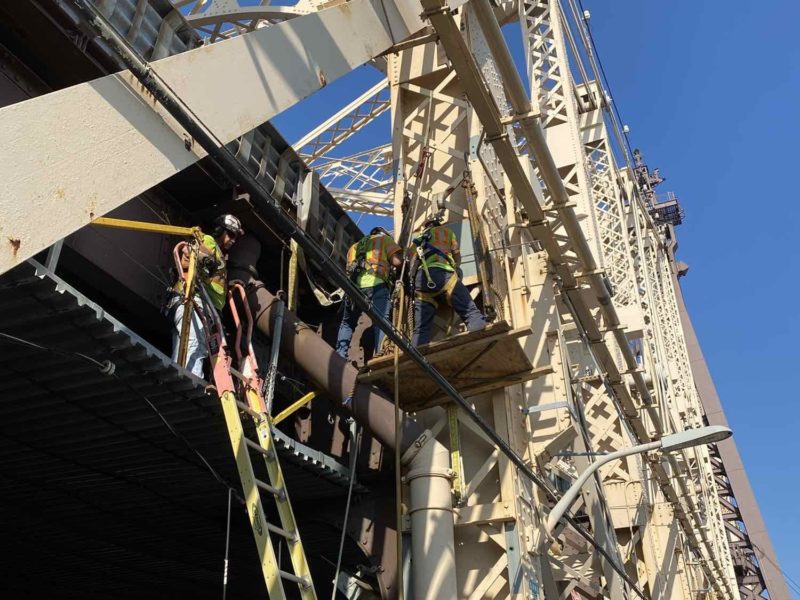
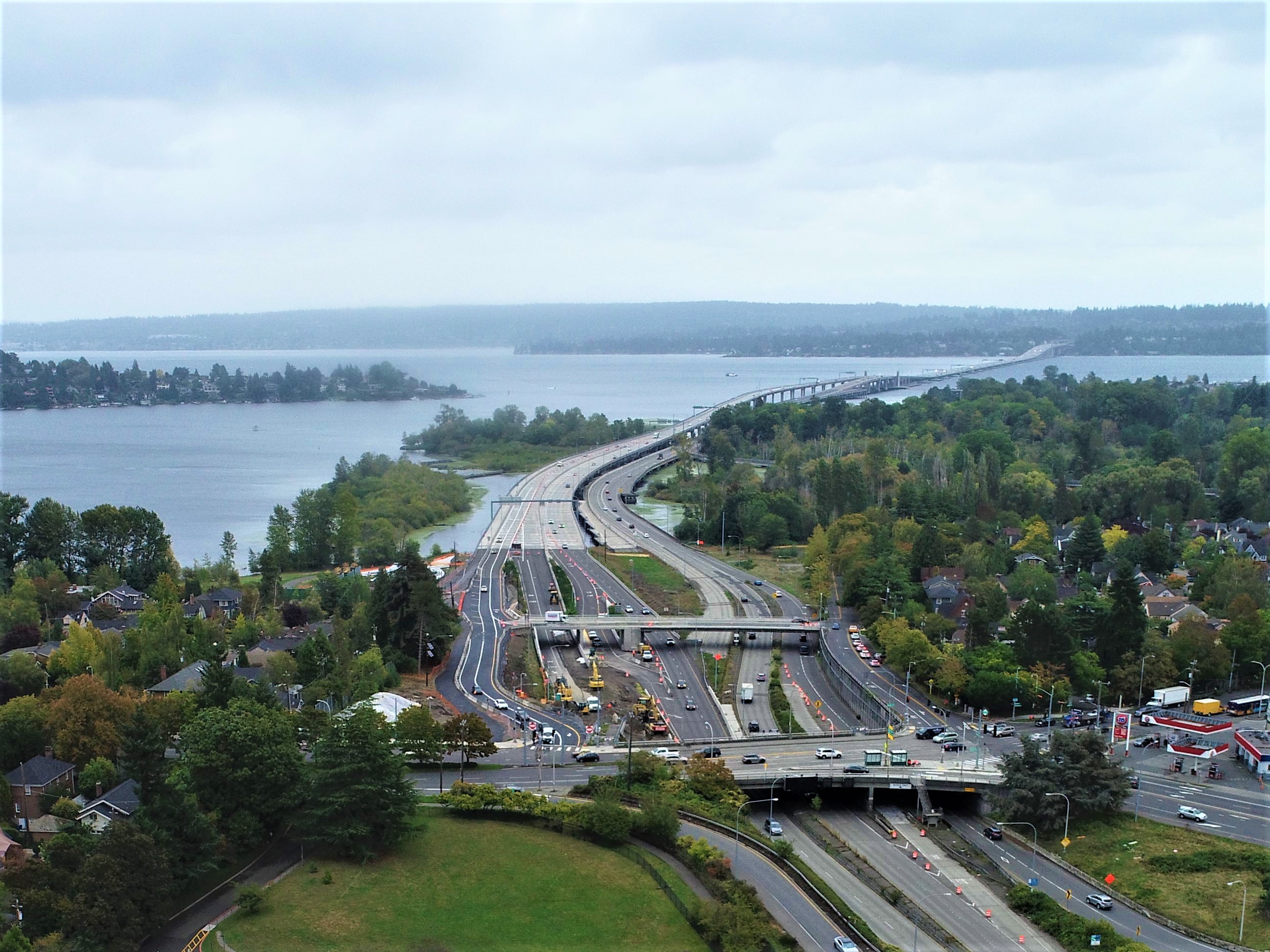
The SR 520 / Montlake to Lake Washington I/C and Bridge Replacement in Seattle, Washington is one of several large construction projects that is a part of the SR 520 Bridge Replacement and HOV Program. This project will help to replace windstorm and earthquake vulnerable structures while improving the environment, mobility, and safety. AB is leading the work associated with the West Approach Bridge South which is a part of the Montlake Phase. This includes the replacement of the existing bridge with a new, stronger, three-lane bridge that carries eastbound traffic from Montlake to the new floating bridge. One of the main goals for this section was to decrease environmental impacts. During the proposal phase, the team developed an innovative trestle construction sequence that reduced pile quantity by over 50% compared to original estimates.
In October 2020, American Bridge Company was acquired by Texas-based Southland Holdings, LLC. Other entities owned by Southland include Oscar Renda Contracting, Johnson Bros. Corporation, Mole Constructors, Southland Contracting, and Heritage Materials. With the combined capabilities of these six subsidiaries, Southland has become one of the largest and most diversified industry leaders within the infrastructure construction space. Southland groups serve the transportation, tunneling, heavy civil, bridges and structures, water treatment facilities and conveyance, alternate delivery, and engineering markets.
